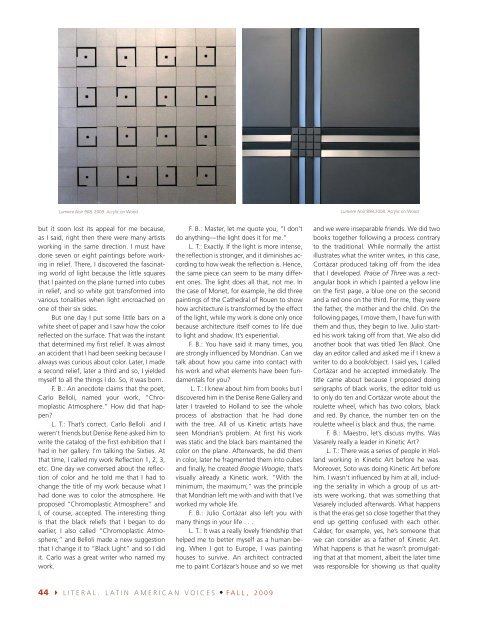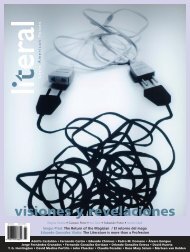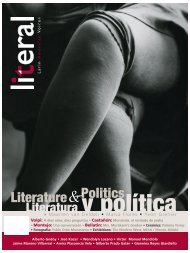Giobany Arévalo > Gabriela Torres Olivares >Anuar Jalife - Literal
Giobany Arévalo > Gabriela Torres Olivares >Anuar Jalife - Literal
Giobany Arévalo > Gabriela Torres Olivares >Anuar Jalife - Literal
Create successful ePaper yourself
Turn your PDF publications into a flip-book with our unique Google optimized e-Paper software.
Lumiere Noir 908, 2009. Acrylic on Wood Lumiere Noir 898,2008. Acrylic on Wood<br />
but it soon lost its appeal for me because,<br />
as I said, right then there were many artists<br />
working in the same direction. I must have<br />
done seven or eight paintings before working<br />
in relief. There, I discovered the fascinating<br />
world of light because the little squares<br />
that I painted on the plane turned into cubes<br />
in relief, and so white got transformed into<br />
various tonalities when light encroached on<br />
one of their six sides.<br />
But one day I put some little bars on a<br />
white sheet of paper and I saw how the color<br />
refl ected on the surface. That was the instant<br />
that determined my fi rst relief. It was almost<br />
an accident that I had been seeking because I<br />
always was curious about color. Later, I made<br />
a second relief, later a third and so, I yielded<br />
myself to all the things I do. So, it was born.<br />
F. B.: An anecdote claims that the poet,<br />
Carlo Belloli, named your work, “Chromoplastic<br />
Atmosphere.” How did that happen?<br />
L. T.: That’s correct. Carlo Belloli and I<br />
weren’t friends but Denise Rene asked him to<br />
write the catalog of the fi rst exhibition that I<br />
had in her gallery. I’m talking the Sixties. At<br />
that time, I called my work Refl ection 1, 2, 3,<br />
etc. One day we conversed about the refl ection<br />
of color and he told me that I had to<br />
change the title of my work because what I<br />
had done was to color the atmosphere. He<br />
proposed “Chromoplastic Atmosphere” and<br />
I, of course, accepted. The interesting thing<br />
is that the black reliefs that I began to do<br />
earlier, I also called “Chromoplastic Atmosphere,”<br />
and Belloli made a new suggestion<br />
that I change it to “Black Light” and so I did<br />
it. Carlo was a great writer who named my<br />
work.<br />
F. B.: Master, let me quote you, “I don’t<br />
do anything—the light does it for me.”<br />
L. T.: Exactly. If the light is more intense,<br />
the refl ection is stronger, and it diminishes according<br />
to how weak the refl ection is. Hence,<br />
the same piece can seem to be many different<br />
ones. The light does all that, not me. In<br />
the case of Monet, for example, he did three<br />
paintings of the Cathedral of Rouen to show<br />
how architecture is transformed by the effect<br />
of the light, while my work is done only once<br />
because architecture itself comes to life due<br />
to light and shadow. It’s experiential.<br />
F. B.: You have said it many times, you<br />
are strongly infl uenced by Mondrian. Can we<br />
talk about how you came into contact with<br />
his work and what elements have been fundamentals<br />
for you?<br />
L. T.: I knew about him from books but I<br />
discovered him in the Denise Rene Gallery and<br />
later I traveled to Holland to see the whole<br />
process of abstraction that he had done<br />
with the tree. All of us Kinetic artists have<br />
seen Mondrian’s problem. At fi rst his work<br />
was static and the black bars maintained the<br />
color on the plane. Afterwards, he did them<br />
in color, later he fragmented them into cubes<br />
and fi nally, he created Boogie Woogie, that’s<br />
visually already a Kinetic work. “With the<br />
minimum, the maximum,” was the principle<br />
that Mondrian left me with and with that I’ve<br />
worked my whole life.<br />
F. B.: Julio Cortázar also left you with<br />
many things in your life . . .<br />
L. T.: It was a really lovely friendship that<br />
helped me to better myself as a human being.<br />
When I got to Europe, I was painting<br />
houses to survive. An architect contracted<br />
me to paint Cortázar’s house and so we met<br />
44 LITERAL. LATIN AMERICAN VOICES FALL, 2009<br />
and we were inseparable friends. We did two<br />
books together following a process contrary<br />
to the traditional. While normally the artist<br />
illustrates what the writer writes, in this case,<br />
Cortázar produced taking off from the idea<br />
that I developed. Praise of Three was a rectangular<br />
book in which I painted a yellow line<br />
on the fi rst page, a blue one on the second<br />
and a red one on the third. For me, they were<br />
the father, the mother and the child. On the<br />
following pages, I move them, I have fun with<br />
them and thus, they begin to live. Julio started<br />
his work taking off from that. We also did<br />
another book that was titled Ten Black. One<br />
day an editor called and asked me if I knew a<br />
writer to do a book/object. I said yes, I called<br />
Cortázar and he accepted immediately. The<br />
title came about because I proposed doing<br />
serigraphs of black works, the editor told us<br />
to only do ten and Cortázar wrote about the<br />
roulette wheel, which has two colors, black<br />
and red. By chance, the number ten on the<br />
roulette wheel is black and thus, the name.<br />
F. B.: Maestro, let’s discuss myths. Was<br />
Vasarely really a leader in Kinetic Art?<br />
L. T.: There was a series of people in Holland<br />
working in Kinetic Art before he was.<br />
Moreover, Soto was doing Kinetic Art before<br />
him. I wasn’t infl uenced by him at all, including<br />
the seriality in which a group of us artists<br />
were working, that was something that<br />
Vasarely included afterwards. What happens<br />
is that the eras get so close together that they<br />
end up getting confused with each other.<br />
Calder, for example, yes, he’s someone that<br />
we can consider as a father of Kinetic Art.<br />
What happens is that he wasn’t promulgating<br />
that at that moment, albeit the later time<br />
was responsible for showing us that quality






